Follow us and stay on top of everything CRO
Read summarized version with
Conversion rate optimization (CRO) is an ongoing practice that involves a lot of wins and failures.
Sometimes, the failures might even seem more prominent than the wins.
Yet, CRO continues to be the go-to choice for businesses all over the world that want to grow, scale, and capture a larger share of the market.
This is because whether you have an eCommerce site, a digital payment app, or a B2B-SaaS platform, conversion rate optimization offers a wide range of benefits that can improve every aspect of your digital platform.
So, if you are still unsure about it, here are some crucial benefits of conversion rate optimization that can give your business the edge it needs to stay ahead of the competition and connect with your users like never before.
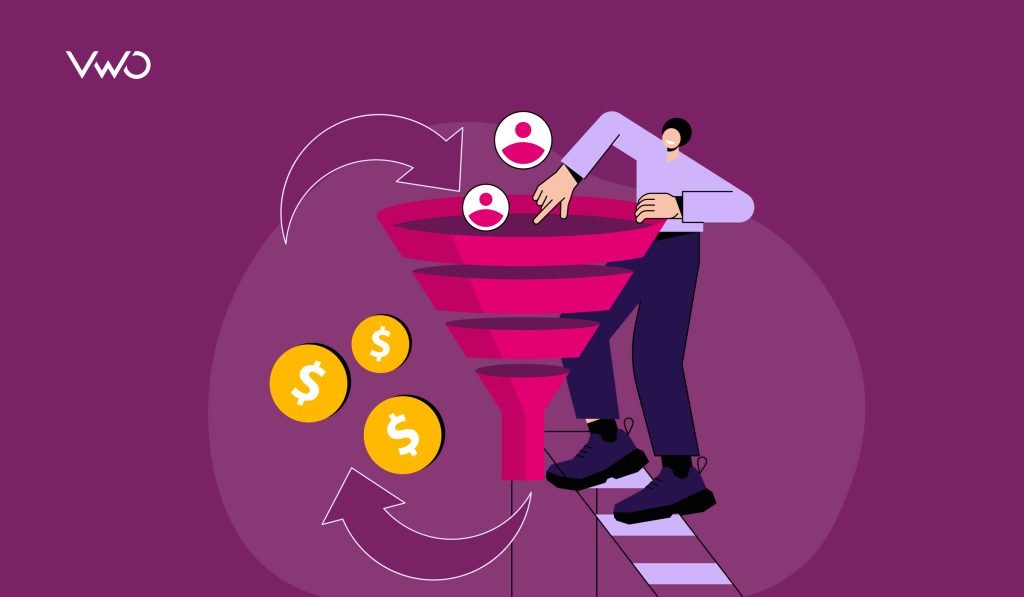
1. Help users achieve their goals
All users arriving on your website or mobile app have a unique goal.
Whether it is finding more information about your service, exploring a certain product feature, or making a purchase on your website, every action they take is defined by their goal.
By implementing CRO, you can carefully analyze these actions and identify patterns in their behavior such as the pages they visit, the buttons they click, and the time they spend on each section.
For example, if a significant number of users abandon a particular page without engaging further, it indicates that the content or layout is not meeting their expectations and it is also not driving them to take the desired action.
Additionally, with experimentation, which is a crucial part of CRO, you get to observe how changes to important elements on these pages can impact customer behavior.
Analyzing these crucial user insights helps you understand what your users are trying to achieve and also allows you to implement optimization strategies that make it easier for users to achieve their goals.
2. Take data-backed decisions
One of the major conversion rate optimization benefits is that it helps businesses adopt a data-driven approach toward improving user experience.
Firstly, CRO involves tracking and analyzing a wide range of metrics, such as the website’s conversion rate, bounce rate, and click-through rate, to gain a comprehensive understanding of user behavior and engagement patterns.
These quantitative data points offer a glimpse of how users interact with a website or app, helping businesses identify areas for improvement and optimization.
Apart from this, conversion rate optimization also includes qualitative research methods, such as heatmaps, session recordings, user surveys, and so on.
These methods give you deeper insights into user behavior and also help you gather user feedback from users about their preferences, pain points, and motivations.
In conversion optimization, this qualitative data complements the quantitative metrics, offering you actionable insights into user perceptions and behaviors.
Based on this valuable data, businesses can confidently make informed decisions about website optimization as well as mobile app optimization, and focus on improving the user experience along with the overall performance of their digital properties.
3. Reduce bounce rate
Users will leave your website if they don’t find what they’re looking for or if their experience isn’t engaging enough.
One of the benefits of conversion rate optimization is that it helps you identify the elements or sections that might be causing users to bounce from the website.
Once these elements are identified, you can prioritize optimizing them based on the impact they have on your bounce rate and other crucial metrics.
For example, let’s say you manage an online blog where you write articles about health, fitness, and self-care. While the individual articles receive a lot of traffic, you notice that the primary landing page where website visitors can explore all the articles has a high bounce rate.
This indicates a poor user experience. To understand more about the reason for the high bounce rate, you can start by analyzing user interactions on the page.
As part of your CRO strategy, let’s say you first observe the heatmap of the landing page.
Heatmaps offer a visual representation of user activity on a page or section of websites and mobile apps. During this heatmap analysis, you notice low interaction on the navigation bar of the page.
Also, you notice high activity at the extreme right side of the page. This is the area where the scroll icon is located. However, the current scroll icon is extremely small which is probably making it difficult for the site visitors to click on it.
These observations indicate that the navigational experience on the landing page is not good and visitors are struggling to find what they are looking for, which is probably why they are leaving the page.
Based on these qualitative insights from the heatmap analysis, you form a hypothesis that improving the visibility of the navigation bar and increasing the size of the scroll icon will improve user experience on the page.
To confirm your hypothesis, you can build a new version of the page with the required changes and run an A/B test to see whether it has the desired impact on user experience and bounce rate.
This is how conversion rate optimization helps discover previously unknown issues and optimize them to deliver seamless experiences to your users.
By implementing CRO strategies effectively, your online business can create a more engaging and user-friendly website that encourages users to stay longer and take the desired action, ultimately reducing bounce rates.
4. Improve the process of lead generation
Capturing and nurturing leads is essential for sustainable growth. Implementing CRO techniques to optimize lead-generation strategies is a good way to attract more customers and boost revenue.
As we saw in the previous example, analyzing customer behavior and testing different design elements can help businesses build web pages that are tailored to attract and engage their target audience.
Whether it’s optimizing the headline copy, refining imagery, or simplifying the form fields, conversion optimization empowers organizations to maximize conversions and capture more leads effectively.
Also, by tracking key metrics such as email open rate, click-through rate, and conversion rate, organizations can identify areas for improvement and refine their communication strategies accordingly.
This iterative approach ensures that leads receive timely and relevant information, ultimately increasing the likelihood of conversion.
5. Boost user engagement and user satisfaction
Businesses, today, strive to create compelling and enjoyable interactions that keep users coming back for more.
This is one of the most important benefits of conversion rate optimization as the foundation of any CRO strategy is based on building experiences that users love.
Let’s consider the example of Medienreich Training, a German software company that provides training for participants from either the same company or even different companies.
Medienreich Training had a wide range of courses that visitors could choose from which included:
- Open training: For participants from different companies.
- Individual in-house training: Customized training for employees of a specific company.
- Individual company training: Tailored to the client’s needs and held at Medienreich’s training centers.
While their primary goal was to increase conversions, they also wanted website visitors to interact with the different offerings on their home page. In other words, Medienreich Training was looking to improve user engagement.
To achieve this goal, the team at Medienreich Training decided to implement conversion rate optimization. Firstly, the team analyzed how users were interacting with the current home page.
The existing home page displayed the three main categories with individual CTAs for each.

However, after studying visitor behavior, the team decided to replace these three categories with 8 of their best-selling courses such as Adobe Photoshop, InDesign, AutoCAD, Microsoft Excel, Microsoft PowerPoint, and others.
The team believed that displaying these best-selling courses would make it easier for visitors to choose a training program and would also reduce their effort of looking for a specific course.
So, the team created a new version of the page (variation) and used VWO to run a Split URL test. The primary goal for this test was to track engagement.
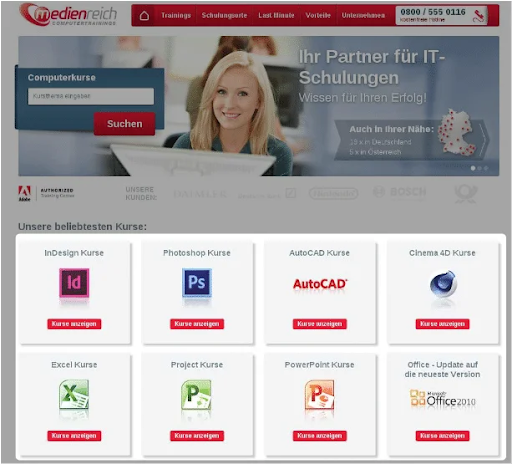
The test continued for around 20 days, after which the variation beat the control and increased engagement by 40.87%.
This is how CRO can help boost user engagement and improve user satisfaction by not only optimizing important elements but also by providing the right information at the right time.
6. Lower customer acquisition costs and boost customer lifetime value
Acquiring new customers is a costly and challenging affair.
For example, the average customer acquisition cost (CAC) for eCommerce brands is $70 while the CAC for B2B brands stands at $536.
However, one of the most important benefits of CRO is that it helps lower your acquisition costs by maximizing the efficiency of your marketing campaigns, landing pages, checkout pages, and every other important element in your conversion funnel.
Rather than investing in costly advertising campaigns to drive more visitors to the website, businesses can start optimizing the user experience to convert a higher percentage of existing visitors into paying customers.
Organizations can increase the return on investment for their existing website traffic by optimizing key areas of user interactions, which helps lower customer acquisition costs.
Moreover, through conversion rate optimization, businesses can analyze various touchpoints in the customer journey and identify the most effective channels, campaigns, or pages that drive more conversions.
This data-driven approach enables you to allocate your marketing budget more efficiently and also allows you to assign more resources to the channels that deliver the highest return on investment, thus increasing revenue, improving overall profits, and boosting the customer lifetime value.
7. Optimize every step of the user journey
Conversion rate optimization serves as a pivotal tool in refining every step of the user journey, ensuring a seamless and engaging experience from initial interaction to final conversion.
Users navigate through various stages of a website or app, and their journey must be optimized to retain their interest and guide them toward desired actions.
Identifying potential friction points and discovering innovative ways to improve them is one of the most crucial benefits of conversion rate optimization.
For instance, consider an online store that wants to enhance its checkout process. While users browse through products and add items to their cart, you notice a significant dropout at the checkout stage.
As part of your CRO strategy, you first conduct in-depth research into user behavior on the checkout page. Also, you must look at your analytics tool to find data about the cart abandonment rate and time spent on the checkout page.
By doing so, you can identify obstacles or challenges that are hindering the checkout process.
Here, you observe the heatmap of the page and notice high interaction around the ‘Pick a payment method’ section. Also, the session recordings show that a lot of visitors are scrolling to the bottom of the page to view other information such as date of delivery, refund policy, etc.
These observations suggest that the layout of the checkout page needs to be improved and the process of picking a payment method also needs to be simplified.
To begin with, you can observe the data about payments and identify the most popular payment methods. Also, you can display important information about the purchase somewhere at the top, so visitors can easily locate them.
Again, to confirm your hypothesis, you can run an experiment and observe how users interact with the improved checkout page. Based on the results of the test, you can either implement these changes for all visitors or you can continue to test different changes and find the best version for your audience.
Whether it’s improving product discovery, simplifying checkout processes, or optimizing post-purchase support, CRO empowers businesses to continuously refine their digital interactions and deliver exceptional value to their audience.
8. Deliver optimized experiences to every user
Catering to the unique needs of individual users is essential for driving engagement and fostering long-term relationships with the user.
One of the key benefits of CRO is that it helps businesses understand their users at a deeper level, which allows them to deliver experiences that their users want and desire.
Let’s consider the example of ArchiveSocial, a USA-based SaaS company that helps businesses fulfill legal requirements and avoid lawsuits on social media.
For the team at ArchiveSocial, the primary goals were to increase leads and boost conversions from their home page and ‘Request demo’ page.
To understand how users interacted on these pages, the team conducted thorough research and narrowed down the following objectives for their conversion rate optimization program:
1. Increase conversions from the banner form on the home page.
2. Accelerate the conversion rate on the pricing page for lead generation.
3. Improve user engagement on the entire website.
During their research, the team made a few crucial observations about these pages.
One of them was that when a user landed on the current home page (original), the email form field was displayed at the very bottom of the banner, and that too without any separation or contrast from the remaining page.
This probably made it difficult for users to notice the form field and resulted in a lot of missed opportunities.
To counter this problem, the team decided to create a new version (variation) of the home page where the email field was given more prominence and contrasting colors were used to improve its visibility.
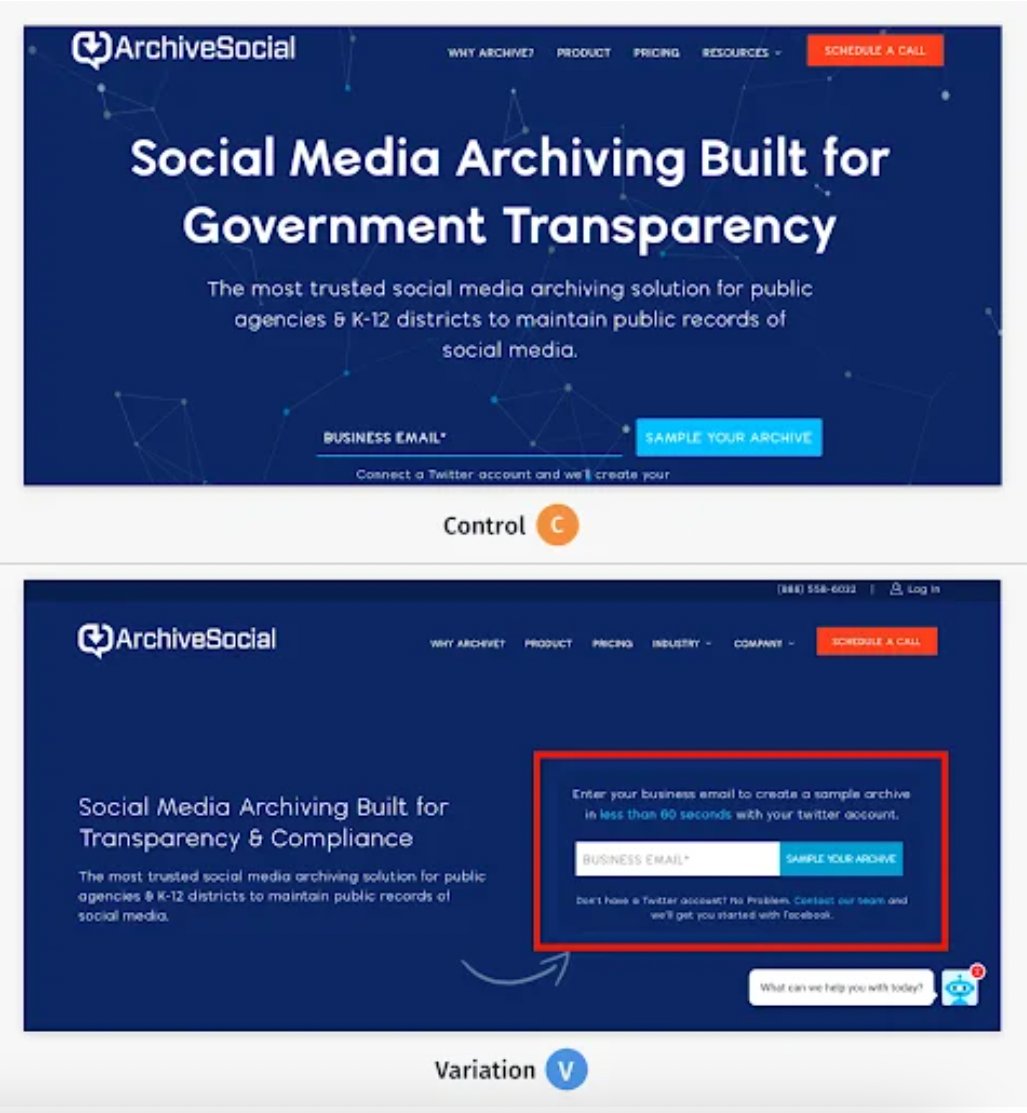
The test ran for 27 days, during which the incoming web traffic was equally split between the control and the variation. After the test ended, the variation was declared as the winner with a 101.68% improvement in clicks on the form field.
Next, the team shifted its focus toward improving its pricing page with an aim to streamline and improve the funnel from pricing to the final conversion page.
To begin with, the pricing page was completely revamped to highlight the primary CTA button. Also, additional text was added to the page to help users better understand the plan details. Moreover, the overall layout of the page was designed to highlight the most popular (mid-priced) plan.
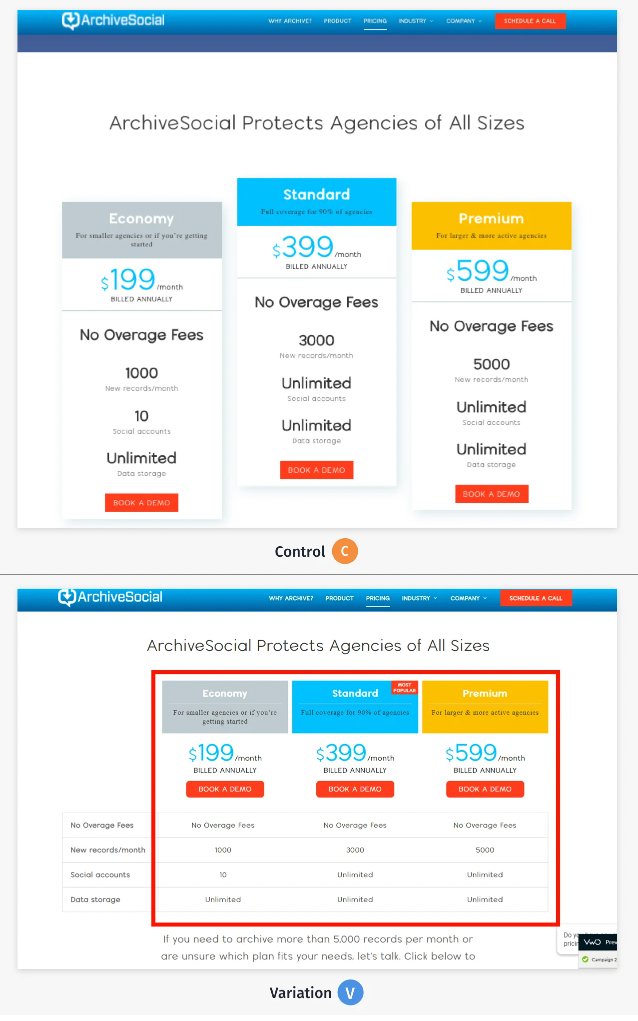
The primary goal of this test was to increase clicks on the CTA buttons on each plan and nudge users to the ‘Thank You’ page to close the conversion loop.
After running the test ran for seven weeks, the variation was declared the winner with visits to the ‘Thank you’ page increasing by 64.76%.
Lastly, the team at ArchiveSocial wanted to drive more website traffic to the gated content on its ‘Resource’ page.
The team formed a hypothesis that shifting the ‘Resources’ section to the top navigation would increase engagement and improve its visibility on the page. A new variation was created based on this hypothesis.
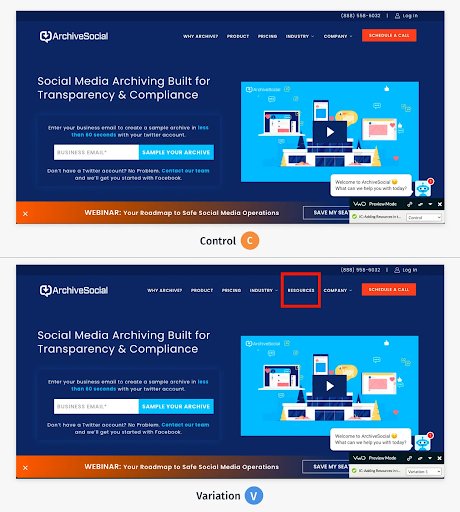
This test ran for around 10 days and ended with the variation registering a 73.30% uplift in traffic to the ‘Resources’ page.
Final thoughts
While there are quite a lot of benefits of conversion rate optimization, the real challenge lies in implementing it effectively and consistently.
But, what’s more important is to understand that your users are humans too. They have their own goals, perceptions, uncertainties, doubts, and challenges.
The best way to implement your CRO strategies is to first identify what your users want and then work towards delivering it in a way they like the most. So, get started right away and enjoy the various benefits of conversion rate optimization.
To learn more about CRO and how you can implement it for your business, take a free trial with VWO and kickstart this incredible journey of optimization.













